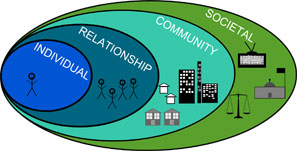In sexual violence prevention work, a model of behavior change is the social-ecological model.

The social-ecological model is used because sexual violence is complex. People perpetrate sexual assault for a wide variety of reasons and as a result of many different influences on their lives. The social-ecological model provides a framework for understanding those different influences and their relationship to one another.
The influences in life that cause sexual violence are spread throughout different contexts — it’s not just violence in movies, or having sexist attitudes or beliefs. Many things influence perpetration and victimization of sexual violence.
Therefore preventing sexual violence is more complicated than other public health issues. This is why it is important our prevention efforts reach people on multiple levels of the social-ecological model.
| The Social Ecological Model | |||
|---|---|---|---|
| Level | Influences | Strategy | Prevention activities example |
| Individual |
Factors that increase risk such as biological, personal history, alcohol/drug use, attitudes/beliefs that support sexual violence |
Promote attitudes, beliefs and behaviors that support equality, respect and non-violence |
Educational sessions that encourage individuals to challenge violence, sexism, racism, homophobia, etc. and comprehensive sexuality curricula that promote healthy sexual relationships that are mutually beneficial to both partners. |
| Relationship |
Relationships with peers, intimate partners, family members can influence risk for sexual violence. |
Promote healthy communication and behaviors by modeling relationships. |
Peer or bystander projects that gives youth tools to change the climate of their social circles by rejecting or intervening when they hear or witness behaviors that support violence, sexism, etc. |
| Community |
Factors that increase risk based on community and social environments, including an individual’s relationships with schools, workplaces, neighborhoods. |
Promote a climate in the community that by targeting processes or policies. |
Launching a social marketing campaign on a college campus that promotes consent and safe practices in sexual relationships. Corresponding workgroup that proposes a student bill of sexual rights. |
| Societal |
Larger, macro-level factors that influence sexual violence such as gender inequality, religious or cultural belief systems, societal norms, and policies that create gaps in service. |
Promote social norms, policies and laws that support sexual freedom, rights and healthy relationships. |
Targeting law makers to increase funding for prevention activities in schools. Creating a program that provides them with reasons to promote prevention: lifelong effects of violence on the community, cost to society, etc. |